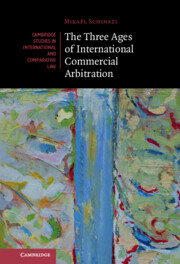Book contents
- Advance Praise for The Three Ages of International Commercial Arbitration
- Cambridge Studies in International and Comparative Law: 163
- The Three Ages of International Commercial Arbitration
- The Three Ages of International Commercial Arbitration
- Copyright page
- Dedication
- Contents
- Figures
- Tables
- Foreword
- Acknowledgments
- 1 General Introduction
- Part I The Age of Aspirations
- Part II The Age of Institutionalization
- 5 Introduction to the Age of Institutionalization
- 6 The Construction of a Coherent Framework for International Commercial Arbitration
- 7 The Development of the ICC Arbitration System
- Part III The Age of Autonomy
- Bibliography
- Index
- Cambridge Studies in International and Comparative Law
6 - The Construction of a Coherent Framework for International Commercial Arbitration
from Part II - The Age of Institutionalization
Published online by Cambridge University Press: 16 December 2021
- Advance Praise for The Three Ages of International Commercial Arbitration
- Cambridge Studies in International and Comparative Law: 163
- The Three Ages of International Commercial Arbitration
- The Three Ages of International Commercial Arbitration
- Copyright page
- Dedication
- Contents
- Figures
- Tables
- Foreword
- Acknowledgments
- 1 General Introduction
- Part I The Age of Aspirations
- Part II The Age of Institutionalization
- 5 Introduction to the Age of Institutionalization
- 6 The Construction of a Coherent Framework for International Commercial Arbitration
- 7 The Development of the ICC Arbitration System
- Part III The Age of Autonomy
- Bibliography
- Index
- Cambridge Studies in International and Comparative Law
Summary
This chapter is divided into two sections. The first probes the origins of the International Chamber of Commerce (ICC) and its Court of Arbitration, from the Atlantic City Conference (1919) to the foundation of the ICC (1920) and its Court of Arbitration (1923). The creation of the Court, a body set up to administer arbitration cases, was a clear sign that international commercial arbitration was becoming more institutionalized. The second section explores the tension between renewal and anxiety in the Age of Institutionalization. It presents the Geneva Protocol on Arbitration Clauses (1923) and the Geneva Convention on the Execution of Foreign Awards (1927) as expressions of that anxiety and the New York Convention on the Recognition and Enforcement of Foreign Arbitral Awards (1958) as signaling the swing toward renewal. Along the way, this chapter hopes to demonstrate that the key “builders” of the current regime of international commercial arbitration were not the “grand old men” described by Dezalay and Garth in their seminal book Dealing in Virtue, but predominantly private business leaders and members of arbitral institutions.
Keywords
- Type
- Chapter
- Information
- The Three Ages of International Commercial Arbitration , pp. 96 - 153Publisher: Cambridge University PressPrint publication year: 2021

